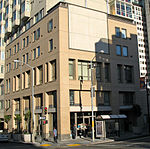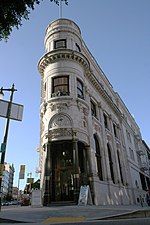Portsmouth Square pedestrian bridge

The Portsmouth Square pedestrian bridge is a prominent architectural landmark in Chinatown, San Francisco that spans over Kearny Street from Portsmouth Square to the second floor and third floor of the Hilton San Francisco Financial District hotel, which houses the Chinese Culture Center of San Francisco.While the bridge is ostensibly meant for pedestrian access to cross the road to the Chinese Culture Center, surveys show that it is rarely used as such, and it gets denigrated by some residents as a "bridge to nowhere." Nevertheless, its brutalist architectural elements and banked sides have made it an attractive space for street skateboarders, from whom it has seen continuous use since the late 1970s, and has been a mainstay in skate media. Skateboarders colloquially call it China Banks. It is also used as a public and private community space. The bridge is currently under consideration for being demolished as part of a complete redesign of Portsmouth Square.
Excerpt from the Wikipedia article Portsmouth Square pedestrian bridge (License: CC BY-SA 3.0, Authors, Images).Portsmouth Square pedestrian bridge
Portsmouth Square, San Francisco
Geographical coordinates (GPS) Address Nearby Places Show on map
Geographical coordinates (GPS)
| Latitude | Longitude |
|---|---|
| N 37.795 ° | E -122.40472222222 ° |
Address
Dr. Rolland and Kathryn Lowe Community Bridge
Portsmouth Square
94113 San Francisco
California, United States
Open on Google Maps










